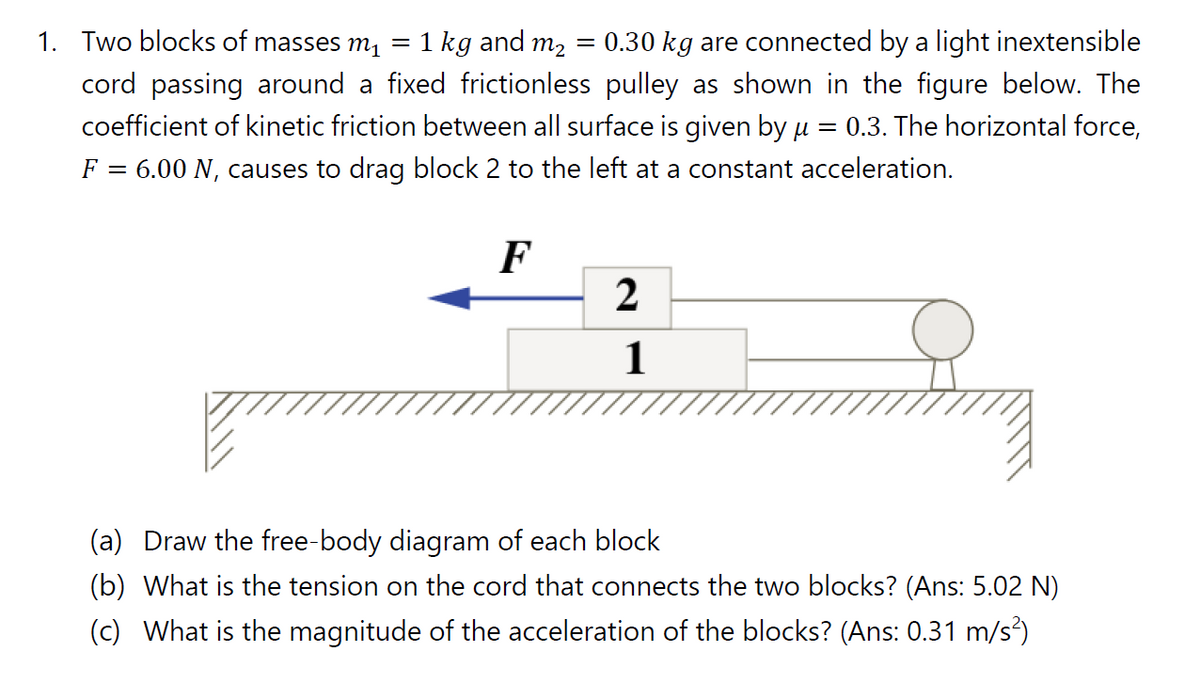Two blocks of masses m = 1 kg and m2 = 0.30 kg are connected by a light inextensible cord passing around a fixed frictionless pulley as shown in the figure below. The coefficient of kinetic friction between all surface is given by u = 0.3. The horizontal force, F = 6.00 N, causes to drag block 2 to the left at a constant acceleration. F 2 1 (a) Draw the free-body diagram of each block (b) What is the tension on the cord that connects the two blocks? (Ans: 5.02 N) (c) What is the magnitude of the acceleration of the blocks? (Ans: 0.31 m/s³)
Two blocks of masses m = 1 kg and m2 = 0.30 kg are connected by a light inextensible cord passing around a fixed frictionless pulley as shown in the figure below. The coefficient of kinetic friction between all surface is given by u = 0.3. The horizontal force, F = 6.00 N, causes to drag block 2 to the left at a constant acceleration. F 2 1 (a) Draw the free-body diagram of each block (b) What is the tension on the cord that connects the two blocks? (Ans: 5.02 N) (c) What is the magnitude of the acceleration of the blocks? (Ans: 0.31 m/s³)
Physics for Scientists and Engineers with Modern Physics
10th Edition
ISBN:9781337553292
Author:Raymond A. Serway, John W. Jewett
Publisher:Raymond A. Serway, John W. Jewett
Chapter5: The Laws Of Motion
Section: Chapter Questions
Problem 51CP: A block of mass 2.20 kg is accelerated across a rough surface by a light cord passing over a small...
Related questions
Question
SHOW COMPLETE SOLUTION

Transcribed Image Text:1. Two blocks of masses m1
= 1 kg and m2 = 0.30 kg are connected by a light inextensible
cord passing around a fixed frictionless pulley as shown in the figure below. The
coefficient of kinetic friction between all surface is given by u = 0.3. The horizontal force,
= 6.00 N, causes to drag block 2 to the left at a constant acceleration.
F
F
1
(a) Draw the free-body diagram of each block
(b) What is the tension on the cord that connects the two blocks? (Ans: 5.02 N)
(c) What is the magnitude of the acceleration of the blocks? (Ans: 0.31 m/s)
Expert Solution
This question has been solved!
Explore an expertly crafted, step-by-step solution for a thorough understanding of key concepts.
Step by step
Solved in 2 steps with 2 images

Knowledge Booster
Learn more about
Need a deep-dive on the concept behind this application? Look no further. Learn more about this topic, physics and related others by exploring similar questions and additional content below.Recommended textbooks for you

Physics for Scientists and Engineers with Modern …
Physics
ISBN:
9781337553292
Author:
Raymond A. Serway, John W. Jewett
Publisher:
Cengage Learning

Physics for Scientists and Engineers
Physics
ISBN:
9781337553278
Author:
Raymond A. Serway, John W. Jewett
Publisher:
Cengage Learning

College Physics
Physics
ISBN:
9781285737027
Author:
Raymond A. Serway, Chris Vuille
Publisher:
Cengage Learning

Physics for Scientists and Engineers with Modern …
Physics
ISBN:
9781337553292
Author:
Raymond A. Serway, John W. Jewett
Publisher:
Cengage Learning

Physics for Scientists and Engineers
Physics
ISBN:
9781337553278
Author:
Raymond A. Serway, John W. Jewett
Publisher:
Cengage Learning

College Physics
Physics
ISBN:
9781285737027
Author:
Raymond A. Serway, Chris Vuille
Publisher:
Cengage Learning

College Physics
Physics
ISBN:
9781938168000
Author:
Paul Peter Urone, Roger Hinrichs
Publisher:
OpenStax College

Physics for Scientists and Engineers: Foundations…
Physics
ISBN:
9781133939146
Author:
Katz, Debora M.
Publisher:
Cengage Learning

Glencoe Physics: Principles and Problems, Student…
Physics
ISBN:
9780078807213
Author:
Paul W. Zitzewitz
Publisher:
Glencoe/McGraw-Hill